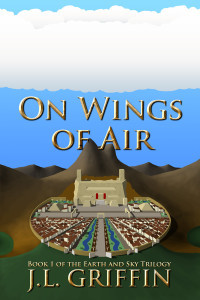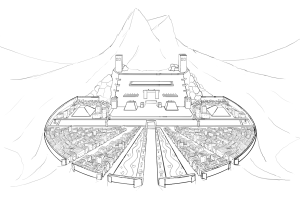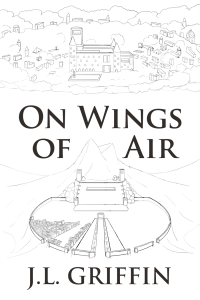Lelia Eye's Blog, page 2
October 17, 2015
Skychildren and the Sky Realm
In the fantasy novel On Wings of Air, there are two specific groups of people who have been enemies from time immemorial: Skychildren and Groundbreathers. As their names suggest, Skychildren are people of the sky who spend their lives in the firmament. Their powers, which were inherited from their goddess and the mother of their race, Celesta, give them the ability to lift themselves with the winds or imbue their powers into special crafts called “gliders” which they pilot through the skies over great distances. They can also call lightning down from nearby clouds and manipulate the winds to bring fog or create vortexes of swift violent winds to deal great destruction. Skychildren also possess an immunity from any harm due to a fall–if any Skychildren were to fall off a cloud, they would not hurt themselves, even if unconscious, as their powers would exert themselves to cushion their landing on the world below. They are able to speak with flying creatures, and their propensity toward using the winds causes them to favor archery over sword-fighting.
Skychildren are a tall and fair people. Their faces tend to be somewhat angular and slender, and they crop their hair, which is usually blond, close to their head. They wear form-fitting clothing to aid with wind resistance, and women wear split dresses which they can button up to form pants to preserve their modesty while flying. Their love of art and beauty is expressed in part through the bright colors of their outfits and the variety of jewelry with which they adorn themselves.
Skychildren are free-spirited and often playful, and they are fast talkers in comparison with those found in the ground realm. Though Skychildren work for a living, they do so with good cheer and happiness in their hearts. Due to their independent natures, Skychildren do not make good servants, as even the lowest scullery maid has a tendency to think herself as good as the royalty she serves. They are, however, respectful at all times, and they remain very loyal to those who guide and direct them. They do have some structure to their society, with a monarch serving as the head of their people. The Cloud Sentinel, under the direction of the Master Sentinel, serve as the guard of the palace, protecting Skychild royalty.
When it comes to the detested Groundbreathers, Skychildren are less than benevolent. Due to the enmity between the goddess Celesta and the god Terrain of the Groundbreathers, that hostility has been passed down through the generations. Skychildren love nothing more than to torment Groundbreathers, and they regularly descend from their cloud cities to raid Groundbreather villages and steal their food. As food in the sky realm can sometimes be scarce, Skychildren often embark on larger raids against their enemies in order to feed their people.
A central characteristic of all Skychildren is their notion of honor. No Skychild would ever think of betraying his people, and they all take their personal code of conduct very seriously. When undesirables are found among the Skychildren, they are generally exiled to the ground world to live among the flightless Groundbreathers and Groundwalkers. When Skychildren are captured during a raid, their honor is considered lost, and they are enslaved by the Groundbreathers. Even if Skychildren are able to escape their captors, they cannot return to the sky realm, as they have become outcasts. As a result, most captured Skychildren tend to accept their fate, living their lives serving those they hate.
The sky realm itself is a collection of large floating mountains in the sky on which Skychildren build their settlements. These floating masses tend to have clouds clinging to the bottom of them which makes them look like large clouds from the ground world below. It is only when one arrives on a settlement that the world in the sky can truly be seen. All sky mountains tend to float throughout the sky at the whim of the air currents, but they usually do not stray very far from Groundbreather lands. However, Skymount, the mountain on which the palace of the Skychildren sits, can always be found hovering near the Groundbreather castle, almost as if the two are joined by some kind of unseen tether that keeps them always aware of their opposing realms.
The various Skychildren settlements serve specific purposes, much like those in the ground world. For example, there is one small settlement which often drifts over the sea, and the residents of that village engage in fishing, using massive gliders built for transporting fresh fish up to the sky realm. In another area, a massive mountain floats, providing not only a large, flat top on which Skychildren grow great amounts of food, but also serving as the one location in the world where Skychildren are able to mine “white gold,” which is used in their wedding traditions and the creation of their wedding bracelets.
September 30, 2015
Cover Evolution: Color Added
Finally, we have a little color to go on the cover. Things really start to become clear now, at least on the ground world. We see the the Groundbreather castle built into the side of the mountain, and now it begins to look like a castle, and the lighter color of the rock of the castle makes it stand out from the mountain behind it. Furthermore, we see the two long avenues with streams running beside it all the way down from the castle to the gates of the town.
Another thing to notice is that the beginnings of the texture, both of the mountains, and on the plateau on which it sits has made it’s appearance. There is still quite a bit of work to do there, but the textures give us more of a 3-d sense than we had before.
The font has also been chosen and is now in place. Those who have seen the Lord of the Rings movies might recognize it–it’s a font that is often used in movies.
The only thing that remains completely undefined is the cloud city, as at present it is nothing more than a white blob. Eventually we’ll see a palace sitting in the clouds, complete with a town to one side. Only a few more posts to go until we reach the final cover!
September 27, 2015
Character Bio: Sequoia
The next character in the On Wings of Air bio series is the Queen of the Groundbreather realm, Sequoia.
Sequoia is no nonsense, possessing a fiery, abrasive personality and very little patience. With her husband, King Tillman, she rules over the ground realm, and while Tillman is the hereditary ruler, Sequoia is typically the mouthpiece for the couple. Furthermore, Sequoia is a strong protector of the Groundbreather people against the constant raids of the Skychildren, and she likes nothing more than to show captured Skychildren the superiority of her people.
For all her seemingly uncompromising inflexibility, Sequoia is actually a good ruler of her people. She has no patience for fools and demands excellence from all those under the realm of her influence, but she is also compassionate, working continuously for the good of her people. While her relationships with her children are generally good, she is sometimes exasperated by her younger daughter Tierra’s tendency to dream of far off places and adventure. Sequoia’s pragmatic viewpoint allows her little use for such frivolities.
September 25, 2015
Cover Evolution: Ground City—Full Sketch
For the next image, we’ll zoom in on the ground city. Whereas before the city was only partially filled in, you can now see that it has buildings drawn into the entire area, with a long boulevard down the center toward the castle.
According to our illustrator, this was the most complicated part of the drawing as it was a challenge to get the perspective right on all the buildings. The castle is set apart from the rest of the city by a large rise, and you can really see where it is fit into the side of the mountain. As the Groundbreathers are a race who are in tune with the earth, metals, rocks, etc., this really shows the solidness of the foundation on which their world is built.
As we stated before, the next post will get into color images, and we’ll really start to see how the world is taking shape. And we’re getting closer to the launch of On Wings of Air itself. The eBook will be on pre-order within about the next week to ten days, and then we have review copies going out soon after. Exciting times!
September 16, 2015
Character Bio: Tempest
Tempest is the king of the sky realm and Skye’s father. Though he does not have a large part in the story, the part he does play is a pivotal one.
As the king of the sky realm, Tempest is fair and honorable, but he possesses a temper and is intolerant of those he deems foolish or those who waste his time. Tempest lost his wife, Dawn, several years before the start of On Wings of Air, and he remarried a lovely young woman named Mista. Unfortunately, Mista is more a subject than a partner to Tempest, and she obeys him without question rather than providing support to him in his role. His attraction to her is obviously based on her physical appearance rather than her mind.
Tempest’s Seneschal is named Hawkins, and Tempest listens to him in almost all things, even favoring his advice over Skye’s. Unfortunately, Tempest and Skye do not share the best of relationships. As one who has little patience with the niceties of his father’s court, Skye disagrees with the more formal and regimented views of his father. Tempest, in turn, views his son as rebellious and works to rein him in. There seems to be a confrontation looming between the two strong-willed individuals.
September 13, 2015
Publishing Tips: Where to Self-Publish
There have likely been entire books written on this subject, but let’s just try to briefly touch on a few things.
So you’ve edited your manuscript, and now you want to know where to publish it. The options seem endless. Google. Apple iBooks. Amazon. Ingram. Kobo. Smashwords. The list goes on. Do you want it to be an ebook? Paperback? Both?
It must be said that the more places you can publish, the better. And a lot of places are even free. But if you’re limited on time, what should you do for the most effect?
Well, you probably don’t want to do Smashwords for your ebook. They have a grueling process involving something called the Meatgrinder. If you don’t follow their guide by the letter, you might find yourself unable to properly publish your manuscript. Honestly, it seems like a lot of work without a lot of payoff. It is to be noted, however, that they distribute to companies like Apple, Barnes & Noble, and Kobo.
I would recommend the path that Jann and I have taken with most of our books: Ingram Spark and Amazon.
Now, with Ingram Spark, you’ll be facing costs. For an ebook, setup is $25. For a paperback, it’s $25. Anytime you want to update the text, you have to pay the money again, so you’ll want to make sure you’ve done things right. Now, Ingram Spark distributes to a lot of retailers, so that will help with your book’s availability. That doesn’t necessarily mean you’ll get your book in brick and mortar bookstores, but it means that you can order your book, for instance, through Barnes and Noble. It’s Print on Demand, so you don’t have to worry about having further costs typically. It is to be noted, though, that since bookstores can order physical copies, you’ll probably want to turn on the option to allow them destroy any copies that don’t get sold; they’re more likely to order books then. In that case, you will potentially have some costs coming out of your book money.
When it comes to ebooks, Amazon is king. You can publish your ebook for free through Kindle Direct Publishing, and it will show up on Amazon’s website. That’s great, as a lot of people (like me) only buy books from Amazon. You can also publish your book in paperback form through CreateSpace. Again, it’s free. Updates are also free, though you may have to wait for changes to take effect. With your book showing up in both ebook and physical (Print On Demand) form on Amazon, that’s a major part of the battle. I’d say that’s even more important than Ingram Spark, to be honest.
One thing to keep in mind is that Amazon does not play very nice with most of the rest of the publishers out there. If you intend to have your book available in bookstores, don’t just publish through Createspace and expect it to show up in your local Barnes & Noble. They won’t stock anything they have to buy through Amazon. For that, you’ll need to go through Ingram. The other thing to note is that if you have done any business through Amazon, Ingram will not distribute to them. So you’ll likely be putting your book up for sale through at least Amazon on Ingram, regardless of whatever else you do.
One other note about physical books: you cannot publish a hardcover through Amazon. As a beginning author, you likely won’t jump right into the world of hardcover books anyway, but if you do, you’ll need to put the hardcover up through Ingram. Unfortunately, you won’t be able to distribute the hardcover through Amazon, but the lion’s share of Amazon sales come from ebooks anyway, so it’s not a problem. In my mind, publishing physical books is solely for the possibility of getting them in brick and mortar stores, and while it is not an easy thing to get a bookstore to stock your books without publisher backing, it is possible.
What about the other places? Well, ebooks on Google are easy to set up for free, so you might consider that route, though you may not make much money. If you have a Mac or want to use an application called a virtual Mac (as iBooks require Publisher to create and upload), you can try to get your stuff to Apple directly instead of going through a middleman like Smashwords. And Kobo, Nookbooks, and iTunes also have a significant presence, so publishing directly to them is probably worth it, especially because they are free to publish.
The bigger point to all this is that if you have problems finding an agent or publisher, you don’t have to despair. The benefits of self-publishing are total control over your work, a larger share of the profits, and the ability to set your own schedule. Of course, publishers provide you with the name backing and marketing–you have to do all that yourself when your self-publish. But self-publishing is becoming a more common way of getting your work to market, and it’s a viable way to make sure your work gets out there. And there is a great satisfaction in doing that!
September 10, 2015
Cover Evolution: Ground Castle Sketch
The next step in the cover evolution focuses on the ground castle. If you compare this sketch with the previous one, you will see that not much has changed in the sky realm; the changes are almost entirely on the ground.
The first thing to note is that the ground castle is surrounded by a town which has been partially sketched out in this image. The town is situated on a plateau which begins to drop not far from its boundaries.
The next thing to note is how there is now a single mountain with a dual peak rising behind the castle, and that the castle itself is actually built into the side of the mountain. It is easier to see how the ground world is laid out in a logical fashion, reflecting the more methodical and ordered mind of the Groundbreathers. Skychildren tend to be much more free-spirited, as can be seen in the haphazard nature of their dwellings.
We’re getting much closer to having an image which looks like the finished product. One more black and white image, and then we’re exclusively into color!
If you missed the previous post, the release for On Wings of Air has been scheduled for November 23. We’re so excited!
September 3, 2015
Publishing Tips: Editing
The second in a series of publishing tips posts. We have exclusively self-published our works, and while traditional publishers are still a viable option, we do have a bit of experience in publishing ourselves. Hopefully there are people out there who will be inspired by our comments and our knowledge.
So, your draft is completed and you are ready and raring to go, looking to jump into the publishing scene with both feet. Unfortunately, the next step will likely take you as long–or longer–than the writing did. In many cases, substantially longer! I’m speaking of editing, of course.
C.J. Cherryh, a well-known fantasy and science fiction author once said, “It is perfectly okay to write garbage–as long as you edit brilliantly.” Never were truer works spoken! Contrary to popular belief, writers do not reel off 800 page manuscripts which are complete and polished and ready to be sold to the adoring masses. The fact of the matter is that written works need to be pored over, massaged, played with, toyed with, and sometimes even completely torn down and rewritten before they are ready for readers to wonder over the perfect placement of words and the majesty of the stories they tell. Yes, I’m being a little facetious, but any writer will tell you the work you are reading has had many edits before it gets to you. Here are some of the things I have found useful in editing my own works.
Set it Aside
After completing a manuscript, I have always found it useful to set it aside for a while. When I am writing something, I am completely engrossed in the writing, and while I will go over what I wrote the previous day, I am still thinking about what I need to write today, so not a whole lot of editing gets done while I’m actually writing. Furthermore, while it is still fresh in my mind, I have a good idea of what I have written, and I will miss mistakes I might have otherwise seen.
How long you put it to the side and leave it alone is your own personal preference. For myself, I am often impatient to get it to print, so it’s sometimes a struggle to let it sit around. A month or two can often be enough to allow the distance necessary for a writer to look at it with an objective eye, but it truly depends on the person. I definitely find it useful to allow the writing to fade from my memory for a while before I start working on it again.
Two Sets of Eyes are Better than One
This one goes without saying, but I will mention it anyway. It is an unfortunate fact that most writers are so familiar with or invested in their own work that it becomes difficult to spot the mistakes in their story. When we read something, we tend to start skimming when we’re familiar with the text we are reading. And when you start skimming, of course you miss things.
Many independent authors don’t have the means to go out and hire a professional editor to go over their work. In that case, it really helps to have a trusted friend–hopefully someone who has some skill in grammar, spelling, etc.!–to look over your work. Having another set of eyes look your work over is extremely beneficial, and can save you the embarrassment of having a book riddled with errors.
Connected with this, you also need to have an open mind about what your editor is telling you. Leave your ego behind and don’t get offended. When you ask someone to look something over for you, that’s exactly what they do. The final decision always rests with the author, but don’t discount well-meaning advice.
Break Out the Hatchet
Don’t be afraid to make cuts–heavy cuts if necessary. There are all sorts of “empty” words you can remove, like “very” or “somehow.” Sometimes, you’ll use five words when two or three can do. Whenever you edit, your general word count should be decreasing. You want your writing to be as “tight” as possible. Oscar Wilde once said, “I’m exhausted. I spent all morning putting in a comma and all afternoon taking it out.” While you don’t need to be quite that obsessed with getting everything perfect, you need to be hyper critical when you review your own stuff rather than just patting yourself on the back for the way something was worded. Think about how some of the words in there are empty or unnecessary or how you can replace six words with two. Longer does not mean better. If your manuscript is getting longer when you edit instead of shorter, it’s possible you aren’t doing something right.
Be especially careful of repeating things. Sometimes you’ll be writing away and you’ll make an important point. The problem is you made that exact point twelve chapters ago. Don’t get down on yourself–we don’t have perfect memories, and sometimes you will write things over again simply because it’s been a month since you wrote it previously. Just removed whatever you repeated and massage the surrounding paragraphs to make it flow properly. But make sure you keep your eyes open for repeats!
Things to Look For
Punctuation. This is a big gotcha when publishing. Are the commas in the right places? Are quotes surrounding speech, and do you have both opening and closing quotes wherever necessary? Are dashes used in the appropriate places? Are your semicolons used properly? Above all, is your punctuation consistent? For example, some programs might use straight quotes, while the font you are using has curly quotes. You should check all these to make sure everything is accurate. Liberal use of the find/replace function will fix these issues quickly and without a lot of fuss.
Grammar. Are your sentences structured properly? Do you have a good mixture of long and short sentences? Run-on sentences? Have you formatted your paragraphs properly?
Word choice. Do all the words mean what you have intended? Do you properly use to/too/two, their/there/they’re, here/hear, its/it’s, and other such words? Do your sentences say exactly what you want them to? Remember, Mark Twain once said “The difference between the right word and the almost right word is the difference between lightning and a lightning bug.” Make sure your manuscript says exactly what you want it to say.
Story continuity. Did that really cool plot you had actually have a resolution, or did you leave the reader hanging, wondering what happened to X? Does your story follow a logical and believable sequence? Will the reader be able to follow it? Sometimes writers want to make things complicated, as it increases the mystery, suspense, etc., but if your reader gets frustrated and puts the book down, you are not doing yourself any favors.
General considerations. Is all the text in your chosen font? Is the text all the same size? Are there any breaks or empty lines where there should not be? Are your section breaks handled consistently? Are your chapter breaks consistent? All these are factors which come into play closer to publishing time, but you should not forget them.
Have Fun
Editing is not always fun. In fact, sometimes after you have been through a manuscript ten times, it can be downright annoying. Remember, however, the wonder of the story as it came from your mind onto the page. Take time to laugh at some of the things you have written. I cannot count the number of times I have read something I’ve written and wondered how I could have written so bad. Don’t be hard on yourself. No one is perfect!
August 30, 2015
Publication Date Announcement: On Wings of Air
Back on May 11 of this year, we published a blog post about our first joint fantasy fiction novel, On Wings of Air. This novel will be the first book of a trilogy entitled Earth and Sky.
We are now pleased to announced that On Wings of Air is undergoing final editing and will be released for purchase on Monday, November 23, 2015. On that date, it will be available as an ebook on Amazon Kindle, Kobo, Nook Book, and iTunes, and it will also be available in mass market paperback and trade paperback formats.
On Wings of Air began as a stand-alone novel almost two years ago, and it has grown into an epic fantasy trilogy in the time since. While the principle writing on this novel was finished in the spring of 2014, it was set aside to focus on other projects for a time and to enable us to develop the themes of the other two books. In the meantime, it has undergone at least five rounds of edits, which means that every detail of the novel has been examined at length, and the story has been polished until it gleams. It also means the novel is essentially error-free, both in grammar, spelling, and continuity.
Lelia and I cannot state how excited we are for this release. It has been a long-held dream for us both to publish fantasy fiction, and On Wings of Air is a worthy first endeavor. We hope all of you will jump on board and enjoy this work as much as we have enjoyed bringing it to you. Our review copies will be going out some time within the next 4 to 6 weeks. If anyone would like to receive a review copy, please contact either of us, and we can tell you how to do it.
Stay tuned for additional information on the release, cover evolution, character bios, and perhaps even a few excerpts from the release of On Wings of Air. We’ll continue to post articles right up to the date it is made available.
And our thanks to everyone who has supported us, provided ideas or thoughts, or inquired about our works. Without the support of our loved ones, this could never be possible.
August 26, 2015
Cover Evolution: Second Cover Sketch
In today’s post for the cover evolution of On Wings of Air, we have a bit of a treat. There are two images for the cover in the next step of the process, and for the first time, we’ll see the cover in a bit of color. First, the black and white image.
As you can see, there is a lot more definition in this cover than in the previous one. Whereas the first sketch was a rather rough drawing which gave a basic idea of the eventual format of the cover, this one gains a little more precision. We begin to see more of the ground city’s logical layout, and though the block which still serves as the castle is still rather plain, you begin to see how it dominates the town around it.
By contrast, the city in the clouds is much more haphazard in nature, with buildings strewn all about, though it too is overshadowed by the large mass of the Skychild palace. Even the characters of the two edifices are different, with the Groundbreather castle being distinctly utilitarian, though it’s not fleshed out as yet, while the Skychild palace is prettier, even at this early stage of the drawing. Another thing you might note is how the towers in the Skychild city are somewhat different from what you saw in the previous image, where they were decidedly Middle Eastern in appearance.
Finally, this is the first draft in which our pseudonym (a pseudonym for multiple authors is called a “collective pseudonym”) appears on the cover. “J” and “L” are our first initials put together, and “Griffin” was chosen because we liked it and thought it sounded suitably fantasy-ish. It’s likely that all our joint fantasy efforts in the future will be published under this name.
Now, as a treat, here is the same image with some color added:
Just a little coloring to go with the cover to give a basic idea of how it will look once the colors are added. Of course it will be much more complex than this–there will be textures, shades, and so on added. But it’s really cool to start getting a sense of how it will ultimately look. And there are some cool effects going on with the font as well!
And there you have it. It’s starting to really take shape!










